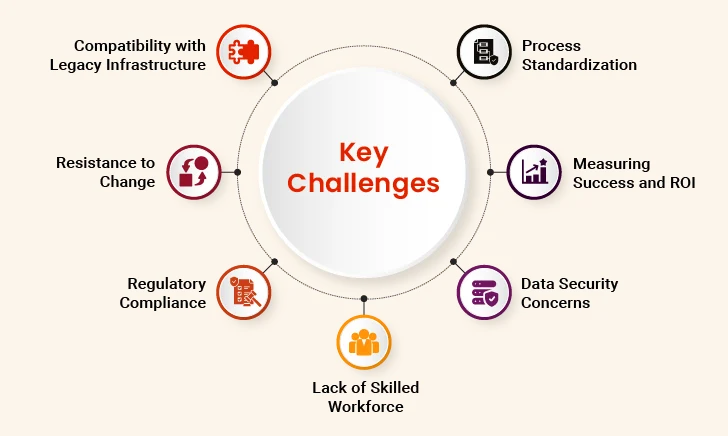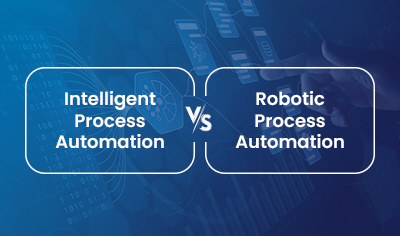With the changing business dynamics, CTOs, CIOs, and other key decision-makers in the banking sector often find themselves at a critical juncture. The urgency to transcend conventional business models by embracing disruptive technologies is no longer a choice but a strategic mandate.

Robotic Process Automation (RPA) presents itself as a formidable growth catalyst poised to revolutionize the way banking processes are executed whilst empowering institutions to recalibrate their operational prowess. What’s more interesting to note is that a single RPA bot can displace up to 30 times the work done by a full-time human employee. Embracing this disruptive technology usually costs one-third the cost of an offshore employee and one-fifth of an onshore employee. Furthermore, the global market size of RPA in banking is estimated to reach 7.1 billion USD by 2031.
Key Challenges for Adopting RPA Solutions in Banking
Robotic Process Automation has emerged as a leader to transform the banking sector. However, as with any substantial leap forward, this technological transformation is not without its set of substantial challenges that demand careful consideration and strategic planning from decision-makers to successfully navigate the intricate landscape of RPA adoption within banking.
1. Compatibility with Legacy Infrastructure
When implementing robotic process automation in banking, one of the common challenges that banking institutions have to deal with is their legacy infrastructure. Today, a large number of institutions still rely on legacy systems that have been developed in the late twentieth century. In fact, 43% of banks in the United States use COBOL, a programming language developed in the 1950s. Integrating RPA technology with these legacy systems can be intricate and may pose compatibility issues. Therefore, it is strongly recommended to meticulously evaluate the adaptability of RPA solutions to coexist with the legacy infrastructure on which the core systems of the banking institutions operate. This will help in ensuring a seamless integration process whilst maximizing the benefits of automation.
2. Resistance to Change
Though the positive impact of Robotic Process Automation solutions has been recognized globally, many banking institutions are still hesitant to embrace this disruptive technology. This indicates that despite the technology’s maturity, its adoption has become a key challenge. It’s important to note that RPA adoption is just the tip of the iceberg of the enterprise-wide automation strategy and a complete shift in mindset and change management is required for successful implementation. In other words, decision-makers need to consider change management strategies that include exhaustive training programs to ensure easy acceptance of robotic process automation within the organizational culture.
3. Regulatory Compliance
Banking is one such sector that operates in a highly regulated environment. Implementing Robotic Process Automation in retail banking can be intricate and pose a slew of challenges. Therefore, it is strongly recommended to conduct a detailed analysis of how RPA solutions align seamlessly with industry-specific regulations. In other words, decision-makers need to make sure that these disruptive solutions adhere to stringent laws and compliance standards.
4. Lack of Skilled Workforce
Using RPA in corporate banking requires skilled professionals who understand both the technology and the banking processes. However, there often aren’t enough professionals with the skills to manage and use RPA tools. This lack of skills can prevent banks from using RPA and limit what they can do. To overcome this, banks should train their current employees to learn the skills for RPA implementation. Banks may also partner with experts who specialize in RPA to help guide the adoption process.
5. Data Security Concerns
Data security is a significant concern for banks when implementing RPA technology in banking. Automating processes often involves using sensitive customer data. If not managed well, this could lead to data breaches or accessed without permission. Banks must ensure their RPA systems follow data safety laws and implement strong safety measures to protect sensitive data. Furthermore, regular audits and monitoring should be conducted to identify and fix problems.
6. Measuring Success and ROI
Finally, measuring the success of RPA adoption may be tricky for banks. Determining KPIs and assessing ROI requires careful planning and tracking over time. Without clear metrics, it may be hard for banks to know if RPA adoption has been worthwhile. To address this challenge, banks should establish specific KPIs related to cost savings, error reduction, and customer satisfaction.
7. Process Standardization
For RPA to work effectively, banking processes need to be standardized. However, many banks have different departments with varying procedures, making it difficult to create a uniform approach. Without standardization, it becomes challenging to implement RPA across the organization. To address this issue, banks should document their processes and analyze them for efficiency. Once they have an understanding of each process, they can work on creating standardized workflows that can be automated. This will help ensure that successful adoption of RPA.
How to Automate Complex Business Processes with RPA
RPA in the Banking Industry: The Key Benefits Businesses Can’t Ignore
RPA has brought a significant shift in the banking industry by offering a multitude of business benefits from improving customer experience to streamlining operations, eliminating human errors, driving productivity, and more. Listed below are some prominent benefits of RPA in banking.
I. Better Scalability and Flexibility
RPA bots are designed to scale seamlessly making it ideal for banking institutions to manage huge volumes of transactions during peak business hours. Besides scalability, it also offers increased flexibility to quickly adapt and meet changing business demands without compromising efficiency. Adopting this emerging technology empowers banking institutions to focus more on innovative strategies and respond to any situation in a record time.
II. Increased Operational Efficiency
Once intelligent bots are implemented successfully, banking institutions can automate mundane, repetitive, and manually intensive tasks with great precision and unparalleled speed, which in turn, makes their processes more efficient. By freeing human resources from rule-based tasks, this emerging technology enables an organization to restructure its workforce to higher-value functions, resulting in increased operational efficiency.
III. Significant Cost Savings
The automation of labor-intensive tasks with the help of Robotic Process Automation solutions translates into substantial cost savings. In other words, automation of redundant, manual, and rule-based tasks that would otherwise require significant manpower allows banking institutions to cut down on high operational costs and reinvest those funds into more strategic growth initiatives.
IV. Underwriter Support
Automated underwriting processes in banking enable making loan-related decisions based on algorithms rather than relying on humans. RPA in underwriting removes the risk of manual error and misinterpretation of loan risks and takes care of biases while making decisions.
V. Strategic Tasks for Employees
RPA implementation in banking allows staff to pay more attention to strategies that support their business growth by freeing employees from doing mundane tasks. It also enables the bank personnel to focus on more critical and strategic tasks that require human intervention.
VI. Increased Accuracy
RPA bots perform recurring tasks with a high degree of accuracy. By minimizing human errors in data input and processing, RPA in investment banking ensures that banks maintain data integrity. This reduces the risk of costly mistakes that can damage a bank’s reputation and financial stability.
VII. Competitive Advantage
RPA helps banking institutions gain a competitive edge. By automating processes and improving efficiency, banks can offer better services, reduce costs, and respond faster to market changes. This helps them attract and retain customers. It can also make them more attractive to investors.
RPA vs Low-Code: Finding the Right Fit for Your Business Needs
Robotic Process Automation (RPA) Use Cases in Banking
Here are some real-life use cases of RPA in banking.
1. KYC Compliance
Knowing your customer is another tedious and time-intensive task that banking institutions need to perform for every customer, and on average, it costs them $2598 per client to perform it in a compliant manner. Incorporating Robotic Process Automation in banking sector can help institutions automate the entire KYC process, which in turn, reduces costs whilst accelerating customer onboarding and improving customer experience.
2. Financial Reporting
One of the easiest ways to monitor financial performance is by generating reports that reflect profit and loss. However, updating P&L on a daily basis is tedious and time-consuming. The good news is that RPA bots can automate this task and generate reports in the desired format in real-time. Besides preparing P&L reports, these intelligent bots can come in handy for:
- Income statements
- Variance analysis
- Balance sheets
- Financial close processes
- Management reports
3. Account Opening
RPA can significantly speed up and simplify the account opening process. While a bank staff manually collects customer information, verifies documents, and enters data into different systems, an RPA bot can do it automatically. The RPA bot can extract data from customer forms, validate it against official documents, and finally input the information into the bank’s systems. This not only makes the process faster but also reduces errors, leading to happier customers. The tedious account opening process becomes much more straightforward, faster, and accurate.
4. Customer Service
Banks handle many customer questions every day, from account details to application status and balance information. It can be hard for banks to respond quickly to all these questions. RPA can automate the responses to common questions in real-time, freeing up human resources for more complex tasks. With the help of AI, RPA can even handle questions that need decision-making. By using NLP, chatbots understand the natural language when engaging with customers and respond like humans. RPA can be employed to automate transaction history requests, account balance checks, and routine customer inquiries. This allows human executives to focus on more complex issues.
5. Accounts Payable Management
Accounts payable management is a simple but cumbersome process in the banking system. It involves extracting vendor information, validating it, and then processing the payment. RPA, with the help of Optical Character Recognition (OCR) solutions, can solve this problem. OCR can read the vendor information from the digital copy or physical form and provide information to the RPA system. RPA will validate the information against the information in the system and process the payment. If any error occurs, RPA bots can quickly notify the executive for resolution.
6. Credit Card Processing
Traditionally, it used to take weeks to validate customer information and approve credit cards. But, with the help of RPA, banks can now process applications within hours. RPA can connect to multiple systems simultaneously to validate the information like credit checks, background checks, documents required and make decisions based on rules to approve or disapprove the application.
7. Mortgage Loan
RPA can automate the underwriting process. Approving a mortgage loan goes through various checks like employment verification, credit checks, repayment history. As the process is based on a specific set of rules, RPA can accelerate the process and clear the bottleneck to reduce the processing time to from days to a few minutes. RPA in underwriting eliminates the risk of manual error, misinterpretation of loan risks, and takes care of biases while making decisions.
8. Fraud Detection
By using AI technology in conjunction with RPA, the banking industry can implement automation in complex decision-making banking processes like fraud detection, and anti-money laundering. Automating fraud detection is faster and more efficient compared to manual detection. RPA employs algorithms and machine learning to analyze transaction patterns and identify fraudulent activities.
Summing Up
RPA in banking operations can be a real game changer since it empowers institutions to improve operational efficiency, reduce costs, and automate a wide range of tasks that are repetitive and time-intensive. If you are also planning to implement this emerging technology, it’s strongly recommended to partner with a professional company that has rich expertise and experience in RPA tools & technology.






